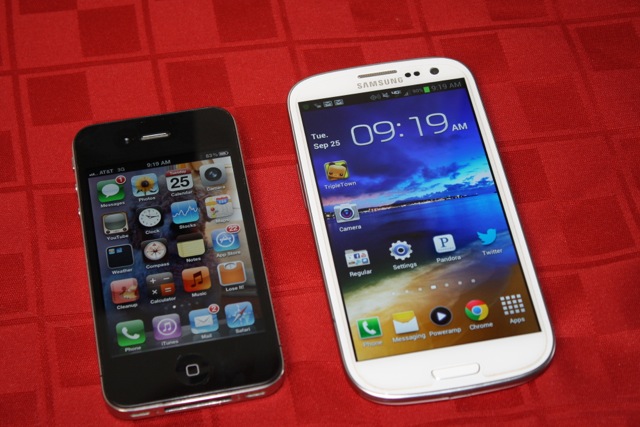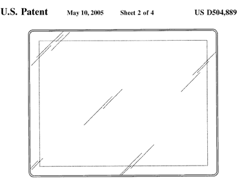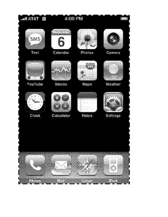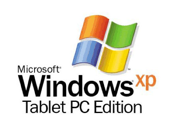If you are unaware that one of the biggest tech lawsuits of the decade just closed a few weeks ago, you’re probably also unaware what its implications meant. If you heard that the jury ruled in Apple’s favor, that Samsung owes the company over $1 billion for allegedly copying its products and violating its patents, you heard right. But these are trivial facts when compared to the actual judicial precedence that has been established with the ruling. Apple, with this recent series of lawsuits, has established that companies can sue others for billions of dollars of damages over trivial design patents, some of which are aesthetic in nature. While this in itself seems logical and just, the accompanying injunctions that Apple filed against 21 Samsung products, most of which only violated a small minute patent, demonstrates major flaws in the US patent system.
Let’s examine the patents.
Utility Patent No. 7844915 is Apple’s patent claim on the “pinch to zoom” graphical effect.
Utility Patent No. 7864163 is Apple’s claim on a “tap to zoom” graphical effect.
Utility Patent No. 7469381 is Apple’s claim on the “bounce back” graphical effect.
Design Patent No. D504889 is Apple’s claim on the “ornamental design for an electronic device”, shown below to be nothing more than a rectangular box with rounded corners and a touchscreen.
Design Patent No. D593087 is Apple’s claim on another electronic device, the basic design of an iPhone, showing its screen and various buttons.
Design Patent No. D618677 is Apple’s claim on the aesthetic design of a slightly updated iPhone, one resembling the 4S.
Design Patent No. D604305 is Apple’s claim on the “ornamental design for a graphical user interface for a display screen or portion thereof, as shown and described”.
Patent No. 7675941 is Samsung’s claim on the method and apparatus for increasing efficiency of voice support over a packet network in mobile devices along with other data transmission apparatuses.
Patent No. 7447516 is Samsung’s claim on an enhanced uplink system for mobile communication and data transmission.
Patent No. 7698711 is Samsung’s claim on an apparatus of multitasking, of being able to control music playback while simultaneously performing other tasks.
Patent No. 7577460 is Samsung’s claim on a data transmitting method for a portable communication terminal that can function both as a phone and a camera.
Patent No. 7456893 is Samsung’s claim on a specific method of storing a digital image and processing it in a digital medium.
While some of these patents may seem innovative, most are vague and insignificant. How are these patents supposed to be protected? Should Samsung sue Apple for violating a few wireless communications patents? Should Apple sue Samsung for creating the Galaxy Tab, a tablet with rounded corners and a touchscreen? Should Apple sue Samsung over minute graphical effects such as “bounce back” or “pinch to zoom” and try to completely block their products? Should Samsung be able to sue over data storage and multitasking patents that Apple may have violated? Should Apple been allowed to patent a “grid of icons” as a design feature, when grids of icons have existed on computers long before?
By law, Apple was allowed to sue Samsung over patents that Samsung, most likely, had violated in one way or another. But then the question must be asked: why were these patents granted to begin with? Pinch to zoom was a concept that existed years before Apple patented it, first developed and used by Mitsubishi. The icon-grid design existed with computers dozens of years ago, and in pre-iPhone Symbian devices. Touchscreen tablets were around as early as 2005, with the Windows XP Tablet PC edition that failed to sell. While Apple “owns” these patents, the technology that they represent was present years before the iPhone.
Another question to ask is why Apple is suing just a few companies over its patents – namely Samsung, HTC, and Motorola. Why not sue Nokia, Huawei, LG, or Asus too? Why choose HTC, or more importantly, Samsung, specifically? Because Samsung is Apple’s biggest competitor. Because the Galaxy S3, their new flagship phone, has sold over 20 million times around the world. The monetary compensation Apple is demanding is not their main purpose; a billion or three billion dollars is meaningless to a company of their size, with a net worth of $683 billion. What Apple really wants to do is to block Samsung’s phones and tablets from US shelves. The Galaxy Tab, Galaxy Note I and II, and Galaxy S3 are all selling tremendously well around the world. By suing over patents that should not have been issued to begin with, Apple is hoping to block their competition in the US.
That’s not to say that the competition isn’t trying to do the same. Ever since the lawsuits first began, companies have been trying tirelessly to block each other’s products from being sold in various countries. Using vague patents, design features, or anything else, these companies do their best to eliminate their competition.
Overall, regardless of who wins each suit, the consumer is hurt by all the litigation. If products are blocked, the consumer is now unable to purchase that product. If legal fees and damages are high, prices of products raise to compensate. All of these “patent wars” can only result in fewer products available to purchase, a condition conducive to monopolization.
Then, the final question must be asked: did a high number of people purchase a product because it had a few similar features to another, or because they liked the other features that it offered over the competition? Within Madison High School, I found that a vast majority of people owned iPhones. “It just works”, according to Billy Kennedy. “Everyone has one”, added Josh Anderson. These people didn’t buy their phones because they had incorporated specific data transfer methods. Likewise, I didn’t buy my Galaxy S3 because it had tap-to-zoom. In the tech market, finding similarities between products is unavoidable. It’s how technology keeps updating; one company finds or invents a new feature that spreads to the whole industry, while another company finds another, and technology continues to improve. Trying to block other competitors’ products for violating small patents is ridiculous. For instance, I don’t see Google suing Apple over the new notifications bar in iOS 6, even though notifications bars have been an integral part of Android for years. It doesn’t matter which company you support; this litigation exists only to protect companies themselves, not the consumer.
Sources:
List of patents in lawsuit:
http://en.wikipedia.org/wiki/Apple_Inc._v._Samsung_Electronics_Co.,_Ltd.
Apple’s “true” intentions behind the lawsuit:
http://www.nasdaq.com/article/apple-is-historys-richest-us-company-20120820-01023
Not about the money:
http://www.nasdaq.com/article/apple-is-historys-richest-us-company-20120820-01023
Apple wanting to block almost all Samsung products:
http://www.engadget.com/2012/08/31/apple-samsung-galaxy-s-iii-galaxy-note-patent-lawsuit/
Description and details of patents in question:




Dylan Anderson • Nov 14, 2012 at 1:51 am
I wish that their was a phone that blended the functionality and user-friendliness of an iPhone, but with the internal specifications of an SIII.